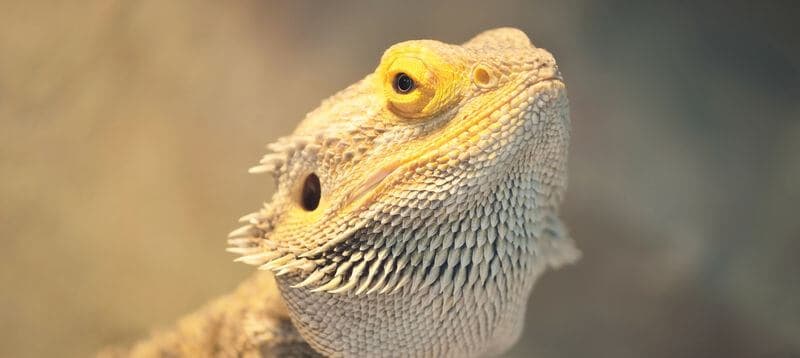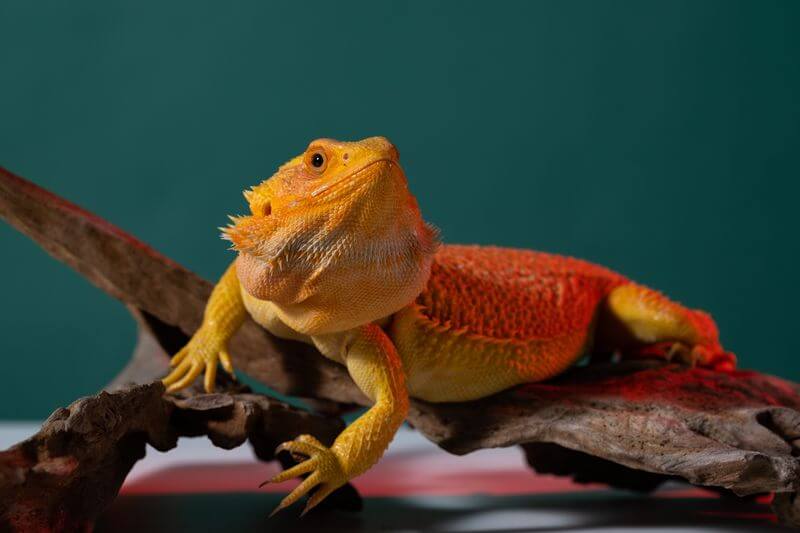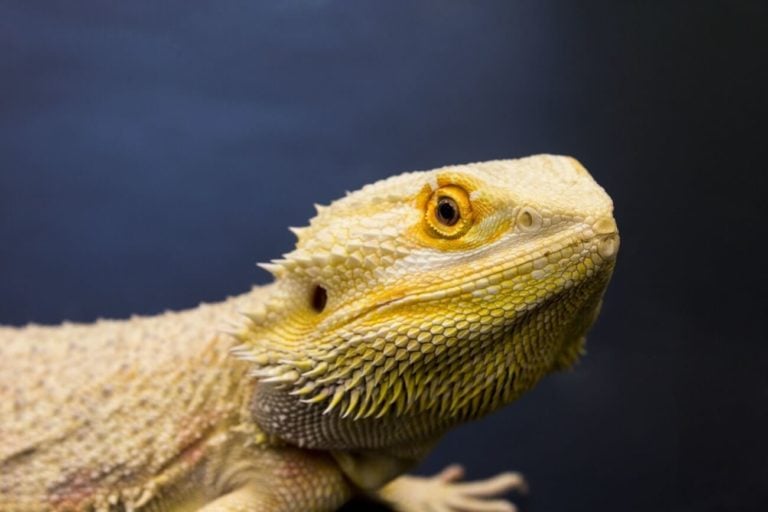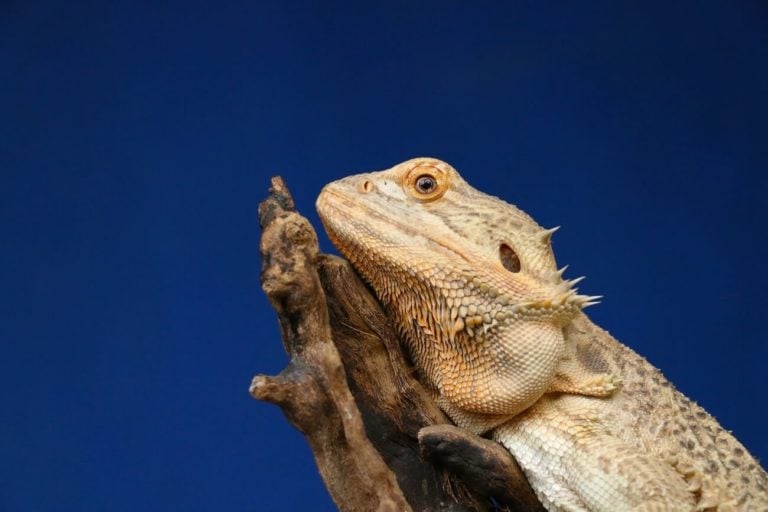Being familiar with bearded dragon vision is very useful if you plan on owning one of these reptiles. It will help you understand their behavior a bit better, and also help them maintain good eyesight!
This guide goes over everything you need to know about bearded dragon vision. You’ll learn if they can see color, see in the dark, and much more!
Table of Contents
How Do Bearded Dragons See?
Bearded dragons primarily see the world through two eyes located on either side of the head. The placement of their eyes is very different from that of humans, and that’s a critical piece of their survival capabilities.
Many animals, including humans, have eyes on the front of the head pointed straight forward. We have a full vision of what’s in front of us and can see a good amount of what’s to the side of us thanks to peripheral vision.
Beardies see things a little differently. Because their eyes focus out from the sides of the head, they have a significantly wider range of vision than we do. They can see more of their surroundings and even get a partial view of what’s in front and behind them simultaneously!

It’s a unique biological feature that helps these lizards survive in the wild. They live among many predators in their natural habitat of desert-like regions in Australia. Having that ultra-wide field of view ensures that lizards can be wary of their surroundings at all times.
They can spot potential predators before they go in for the attack, giving the lizard plenty of time to make an escape. But that’s not all.
Here’s a little-known fact: bearded dragons also have a third eye!
It’s between the two primary eyes and works explicitly to detect shadows and changes in light. Called the parietal eye, it consists of a retina and a lens. However, it has no iris.
A thin layer of skin covers it, providing ample protection. If you look closely, you can see it. The parietal eye looks like a tiny gray dot on the top of the head between the eyes.
This eye serves a few different purposes. First, it helps the bearded dragon distinguish the time of day. It uses this eye to know when it gets dark and whenever something moves above it to block light. Some researchers also found that the parietal eye plays a big part in helping the lizard find their way back to the protection of their home.
Do Bearded Dragons Have Good Eyesight?
Bearded dragons have surprisingly good eyesight. Many other species in the reptile kingdom have a tough time seeing what’s in front of them, but that’s not the case with bearded dragons.
The unique position of the eyes paired with that third parietal eye allows them to make sense of the world around them. Furthermore, their eyes are capable of detecting objects a decent distance away.
Pay attention to your bearded dragon’s reaction as you move around a large room. They often follow objects with their eyes, observing them closely. Some owners even say that they track distant airplanes that catch their eye!
The fantastic vision of this reptile makes it a worthy contender in its natural habitat. In captivity, it also helps the lizard familiarize itself with its surroundings and distinguish its owner from others.
Can Bearded Dragons See In Color?
Not only can bearded dragons see in full color, but they can see color better than humans do.
Humans use three cones in the eye to see color. Bearded dragons use four. They’re considered tetrachromatic. What does that mean?
Simply put, they can see more colors than humans can’t even fathom! We have no way of seeing the world through a bearded dragon’s eyes, but researchers believe that they have a much wider color spectrum than humans.
Furthermore, they may be able to see UV light. UV rays are invisible to the human eye, but it’s possible that bearded dragons can see them. That may contribute to how bearded dragons find places to bask in the wild while staying healthy.
In captivity, you must provide UV light. But in the wild, these reptiles have to find it on their own by moving beyond their homes and basking in the sun. Their ability to see UV rays is a crucial survival trait that ensures they get enough Vitamin D to avoid issues like metabolic bone disease.
Can Bearded Dragons See In The Dark?
There’s a common misconception that bearded dragons are nocturnal. People see them basking under a lamp and assume they sleep the day away for nighttime activity. However, that’s not true.
Bearded dragons are diurnal like humans. That means that they sleep throughout the night and are most active during the day.
Because they sleep at night, they have no biological need to see in the dark. These lizards have lousy vision at night, but that’s fine. As mentioned earlier, the parietal eye detects changes in light and lets the reptile know when the sun goes down. That’s all the information they need.
As long as it’s dark in the enclosure, they’ll go to sleep.
Never keep your lights on at night. No matter how much you think it’ll benefit your bearded dragon, keeping those lights on does more harm than good. Like any other animal, these reptiles have a strict circadian rhythm that you must maintain.
A fully illuminated enclosure will keep your beardie awake. That parietal eye will detect the light and make it impossible for your lizard to get proper sleep. That could eventually lead to hormonal issues, crankiness, and declining health.
Set your lights on a timer and ensure that your bearded dragon gets 10 to 12 hours of pure darkness to rest the night away.
How Far Can Bearded Dragons See?
Unfortunately, there’s no way to know exactly how far bearded dragons can see. But as we mentioned earlier, it’s clear that they have excellent vision that allows them to see clearly from a relatively far distance.
Your lizard will have no problem tracking you from across the room. If you drop a food item within the lizard’s line of sight, it’ll likely run after it and catch it despite being far away. But exactly how far bearded dragons see objects is unknown.
Some reptile enthusiasts swear that their lizards can track extremely distant objects when taken outside. That may be true.
What we do know is that a bearded dragon’s eyes always focus on something in the distance. They only switch to near-focus mode whenever they need to track something close to them. For example, they’ll focus on you moving your hand near their head.
The same goes for live feeder insects you plop into the enclosure. Observe your lizard’s eyes closely; you can see the pupil become larger whenever they’re looking at something nearby.
Every other time, the pupils usually contract into small dots as the lizard pays attention to its surroundings. Once again, it’s all about survival. Focusing on distant objects versus near objects ensures that your bearded dragon can spot potential threats before they get close.
Depth Perception
Another interesting thing we know about bearded dragon vision is that they don’t have the best depth perception. They have a hard time judging distances, and it’s often why they run into objects or leap from precarious heights. These animals can’t tell how far away things are, and their best judgments are sometimes way off!
The lack of depth perception comes from the position of the eyes. Because their eyes are pointed to their sides, they can’t view directly in front of them as humans can. They can only see a tiny sliver. Imagine trying to see what’s in front of you using peripheral vision alone.
That’s what it’s like for bearded dragons.
Ways You Can Aid Your Beardie’s Vision
Vision is crucial for a bearded dragon’s survival and well-being. As an owner, it’s your job to support their ocular health in every way possible.
The best thing you can do is provide a balanced diet that meets the lizard’s unique nutritional needs. That means offering up a mix of live insects, nutrient-rich greens, and plenty of supplements.
Don’t forget to invest in supplement powders. Bearded dragons need calcium, Vitamin D3, and multivitamins. Dust feeder insects with supplement powders to ensure your lizard gets all the vitamins, minerals, and micronutrients required to thrive.
Ocular health is directly linked to overall health, so keeping your lizard in good shape makes all the difference.
Another thing you can do is install a suitable lighting rig. Bearded dragons should get 12 to 14 hours of light every day. They also need UVB light for Vitamin D and calcium metabolism.
Set your lights on a timer and make sure they turn off at the same time every day. Darkness is equally as crucial to bearded dragons as light. Failing to turn off the lights at night could throw off their sleep cycle, putting them at risk for many health problems.
The animal’s ability to detect lighting changes means that you need to provide total darkness every night.
Conclusion
As you can see, bearded dragons actually have very good vision! These reptiles can see color better than we can, and pick out things from a distance with relative ease.
We hope this guide was helpful. If you have any questions, feel free to ask us.



